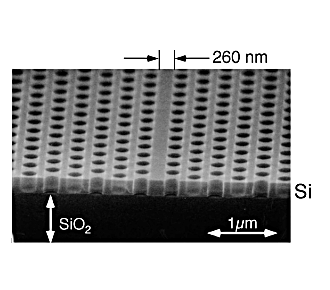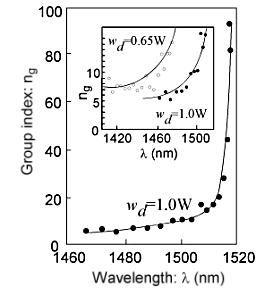Physical Science Laboratory
Ā@Photonic crystal is an artificial dielectric structure of which refractive
index is periodically modulated with the wavelength-scale dimension, which
can be fabricated by the state-of-the-art nano-fabrication technology. This
crystal has a photonic band gap when a certain condition is satisfied, and
then it becomes an exotic photonic insulator which rejects the propagation
of light without any absorption. This unique feature is expected as a cutting-edge
break-through technology for realizing future photonic large-scale integrated
circuits (LSI) because we can confine the light in a ultrasmall volume by
using this crystal.
Ā@With these motivations, we started the fabrication of Si-based photonic crystals with a strong collaboration with NTT Telecommunication Energy Laboratories by using e-beam lithography and dry etching, and have already reported a successful realization of two-dimensional photonic crystals on SOI substrates having a wide photonic band gap between 1.3 to 1.6 É m covering today's fiber communication wavelengths. Recently, we fabricated efficient single-mode optical waveguides that operate within a photonic band gap wavelength. In a photonic crystal having a gap, a line defect has a potential to serve as a tightly confined single-mode optical waveguide, but practically this was not an easy task especially for SOI-type photonic crystals. We have solved this problem by tuning geometrical structure of a line defect in various ways, as shown in Fig. 1 [1]. In addition, we have directly measured dispersion of photonic crystal waveguides for the first time, and clarified that they have extremely large group dispersion, and the traveling speed of light can be largely reduced down to 1/100 of the speed of light in air as shown in Fig. 2 [2]. This large reduction of traveling speed is a direct manifestation of tunability of light propagation in photonic crystals beyond the limitation of material itself. This tunability is especially important for high-speed photonic information processing and also for enhancement of light-matter interaction.
[1] M. Notomi et al., Electron. Lett. 37 (2001) 243.
[2] M. Notomi et al., Phys. Rev. Lett. 79 (2001) 253902.
 |
 |
||||
|
|